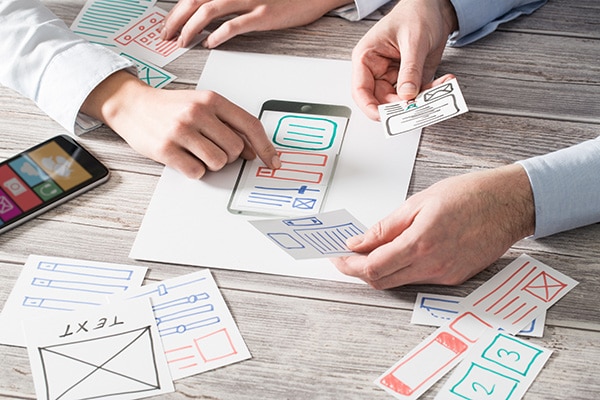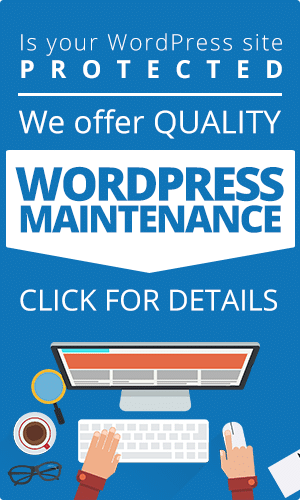It’s not enough to have a website for your business. Now, you need a website that’s carefully crafted with everything customer-related in mind.
The most important way to create a successful site is through its user experience design.
But what, exactly, does that mean and how does it affect your business?
Here, we’ll tell you all the answers and even give you several helpful tips. Do you want higher sales? Happier customers?
Read on to discover how UX design accomplishes this.
What Do We Mean By UX Design?
User experience design (UX design) is the chameleon engine in the virtual room that makes everything run smoothly. Although many business people interchangeably use the term with “user interface design,” the two are slightly different elements.
UI Design
User interface design is about aesthetics. Digital wizards work their magic to make your website look spectacular. The crystal-clear photos, embedded videos and icons are all aspects of UI design.
Examples of UI design include the following:
- Color choice
- Font choice
- Controls placement
- User-friendliness of the interface
UX Design
UX design worries less about what is visually appealing and more about what works or doesn’t work for the customer. Using research, they seek to create an online experience that is catered in every way to the target audience.
Their main goal is to focus on the customer’s overall feelings and experiences. They use data to find what customers desire and integrate it for an overall positive online experience. As such, UX design includes elements of UI design processes, but they also take everything a step further:
- Aesthetics
- Ease of access
- Functionality and processes
- Usability
- Sitemap design
You can see why the two terms get mixed up. User experience design relies on many elements utilized in the user interface to create a positive experience for customers.
UX design is all about the feelings a site instills in its viewers.
Who Benefits the Most?
Focusing on user experience benefits customers and businesses alike. Many corporations or entities particularly benefit:
- Those selling products or services online
- Anyone with a complex and intricate system
- Those incorporating large amounts of data online for viewers to peruse
- Startups
- Apps
While one could certainly argue UX benefits any website, all the mentioned rely on positive customer experiences to grow.
The Big Debate
There are various kinds of design teams that work in a company, and not all of them get along.
Debates surge about the usefulness of UX when it is so closely linked with UI. Computational designers complain about the impossible desires of commercial and classical designers while they complain computational desires are out of touch with consumers.
Then business owners have to worry about the cost of hiring several types of designers without directly verifiable results. Researchers can pour over click rates and sales all they want, but the exact reason conversion rates soared is sometimes impossible to pinpoint.
But through the catcalls and hissing, one thing remains clear: online success requires knowing your customers. UI and UX offer the elements that cater to their needs, and together, the two foster business growth.
To give you a taste of what UX offers, in 2009, Airbnb had fewer than a thousand registered hosts. After employing UX elements and focusing on empathizing with its target customers, it became the “$31 billion behemoth” you see today. Presently, it is at the forefront of short-term lodging.
So while some may question the time and expenses of UX, it will only help your company grow.
How User Experience Design Affects You
You might have a general idea of how researching and responding to customers’ emotions about your site affects the business, but what we’ve covered is only the tip of the iceberg.
SEO Rankings
Today, Search Engine Optimization (SEO) is one of the most important factors in determining whether a company is successful. SEO refers to your business’s ranking, where it shows up when someone searches for the services or products you offer.
SEO rankings are determined by Google algorithms, the specifics of which are somewhat mysterious. However, experts all agree the following increases your ranking:
- Long surf times where customers remain on your website
- Click rates
- Valuable content
- Quick load times
- Accessibility for all devices
The list of characteristics impacting SEO is extensive, but just from the above factors, it’s easy to see how UX affects SEO.
By understanding and researching the customers, your site is optimized to make them happy. The very characteristics that improve SEO also improve customer satisfaction. Consequently, they spend longer times at your site and boost your SEO higher.
Conversion Rates
Knowing what your customers want and giving it to them pays off. Recent research finds a better UX design could increase conversion rates by 400% for a company.
Conversion rates indicate the percentage of website visitors who are converted into customers. This statistic speaks for itself. By investing the money and time into user experience, companies enjoy higher sales and a broader consumer base.
Customer Retention
Approximately 88% of customers won’t return to your site if they have a single bad experience on it.
A site that functions smoothly, engages viewers and is convenient to use increases customer retention. Consumers are more likely to return to that website in the future for similar purchases or services because it becomes connected with a positive experience.
UX allows you to hook and keep customers.
Trust
Almost half of website users cite design as a top indicator of credibility. After all, if they can’t find the information they’re looking for or easily drop an item into the shopping cart, why would they trust you to handle their business?
Past and present studies alike indicate user experience is directly related to trust. Improving the ease of use and usability of your site increases a customer’s trust in you, which encourages them to select your service or item.
Flow alone is a huge predictor of trust in e-commerce websites.
Maintaining trust with all audiences is no easy feat. Individuals in Generation Y, for instance, are extremely emotional and the least loyal of the past generations.
Brand Recall
The psychology associated with positive feelings increases brand awareness and recall through the broaden-and-build theory. This theory states when an individual experiences positive emotions, they associate the sensation with feelings of “oneness” with the object that caused the emotion.
When a site visitor has a positive online experience with the company, autonomic arousal occurs, linking the sensation to the company itself. This broadens the consumer’s cognitive awareness and captures his or her attention.
Thus, brand identity and awareness are increased through the flow experience among other UX designs.
Improvements
The very research conducted to determine how to improve a website betters the entire company. UX design’s implications reach further than the virtual world. The data used to propose new alternatives and speculate different processes is advantageous to the business’s entirety.
Owners can use this data to create a better relationship with customers in other departments, such as marketing and sales.
How to Optimize Your Site
Now that you understand the importance of the user experience design process, chances are you’re wondering how you can improve your business’s online UX design. While hiring a professional who will research and analyze target audiences is best, these tricks will encourage positive reactions in site visitors.
Load Times
Although studies vary, some reports demonstrate 40% of visitors will abandon a page if it hasn’t loaded in three seconds. A single second delay cuts conversion rates by 7%.
Luckily, it’s easy to analyze how fast your site is. Use a free service like Google’s PageSpeed Insights to get all the handy data on your webpage.
To improve load times, select a speedy host server and optimize images. Large images or improperly embedded media (such as videos or audio) takes longer to load. Here is an article containing 8 easy ways to speed up your website.
Organization
Have you ever tried to find information on a website and it was nowhere to be found? It’s a frustrating experience.
Avoid this pitfall by having a clear, simple navigation design.
These three laws used in UX design are helpful:
- Hick’s Law: The fewer choices a consumer has, the easier his or her decisions will be.
- Fitt’s Law: Use interface sizing and positioning to ease navigation and interactions.
- Miller’s Law: Utilize chunking to simplify complex tasks that may be overwhelming.
By integrating these elements, consumers have limited choices, easy-to-find navigational buttons and cues and organized options. This heightens the ease of use and navigation within the website, increasing customer satisfaction.
Accessibility
If you haven’t taken the time to make your site accessible for mobile devices and to all audiences, do it. Mobile shopping is increasing at alarming rates, with statistics indicating up to 198.8 million people will shop via a mobile device in the US in 2018.
If your site doesn’t cater to this crowd, chances are you’re not taking your target audience seriously.
Use mobile plugins to make your site mobile-friendly to accomplish this task.
While you’re at it, consider touching up your website to make it easily navigatable by individuals with disabilities. There are a number of ways to accomplish this:
- Use alt tabs
- Offer closed captioning and transcripts
- Include an accessibility guide
- Add in coding for larger clicking areas
By increasing accessibility through UX design, you increase the number of people who will be “wowed” by your site.
Content Value
Don’t create an uninformative website. The content should be snappy, to-the-point and visually pleasing.
To truly create valuable content, you must know your audience. What kind of tone, style, colors and pace would they prefer in their online experience? Answering these questions and analyzing your target audience through research is the only way to manifest content your consumers will respond to.
Utilizing jargon or other “inside” notions decreases trust, as do uninformative websites in general.
Flow Experience
“Flow” is a psychological term coined by Mihaly Csikszentmihalyi. It describes a mental state in which a user is so immersed in his or her activity, the world around them “disappears.” The individual acts effortlessly to achieve his goal and enjoys a heightened sense of awareness.
In addition to the real world, this state is accomplished online. With the right user experience design elements, a website engages the visitor so well she won’t have to think about clicks or page loads.
Optimal flow experience leads to positive associations, increasing trust, brand awareness and sales.
To improve flow, consider link placement, hover options and content size. All of these act as indicators letting the visitor know what will happen if they click on something. They also are gentle hints about where to go next.
Remember: for flow, simpler is better.
Visuals
Visuals create natural stopping points for the eyes, making them a valuable tool for directing site visitors. Integrate them to lead the way to useful information or to engage the customer. After all, no one appreciates boring sites.
If your webpage is visually engaging and provides valuable content, consumers are more likely to stay on it for longer periods of time. That, by the way, increases your SEO ranking.
Images cross language barriers and say something about your company. To create positive responses from consumers, keep images relevant to the content and balanced on the page.
Consider integrating photos including happy human faces. These evoke natural responses from consumers, evoking positive feelings.
Finally, use visual cues for calls to action, which help viewers know where to go or what to do next.
Buying Experience
The buying experience must be professional, efficient and safe.
Don’t try to wheedle extra information you might use in analyses later. Studies demonstrate companies that request extra information for purchases rarely get sales. Instead, ask for the bare minimum and request consumers partake in a survey if need be.
Walk visitors through the entire sales process, from finding the item that’s right for them to providing relevant information about it to actually purchasing it.
This is one of the best methods for creating a positive user experience.
Let Innovative Solutions Group Increase Your Customer Satisfaction
Integrating successful user experience design tactics has a trickling effect. It increases SEO ranking, conversion rates, trust, brand recall and customer retention. Putting it simply, if a company wants to do well, they should invest in UX.
But it’s not a simple process. That’s why we’re here to help.
Innovative Solutions offers several web design services to make your company’s site successful, engaging and uplifting for consumers. Use our website cost calculator to obtain your free estimate and get one step closer to more profits, higher conversion rates and happier customers.






